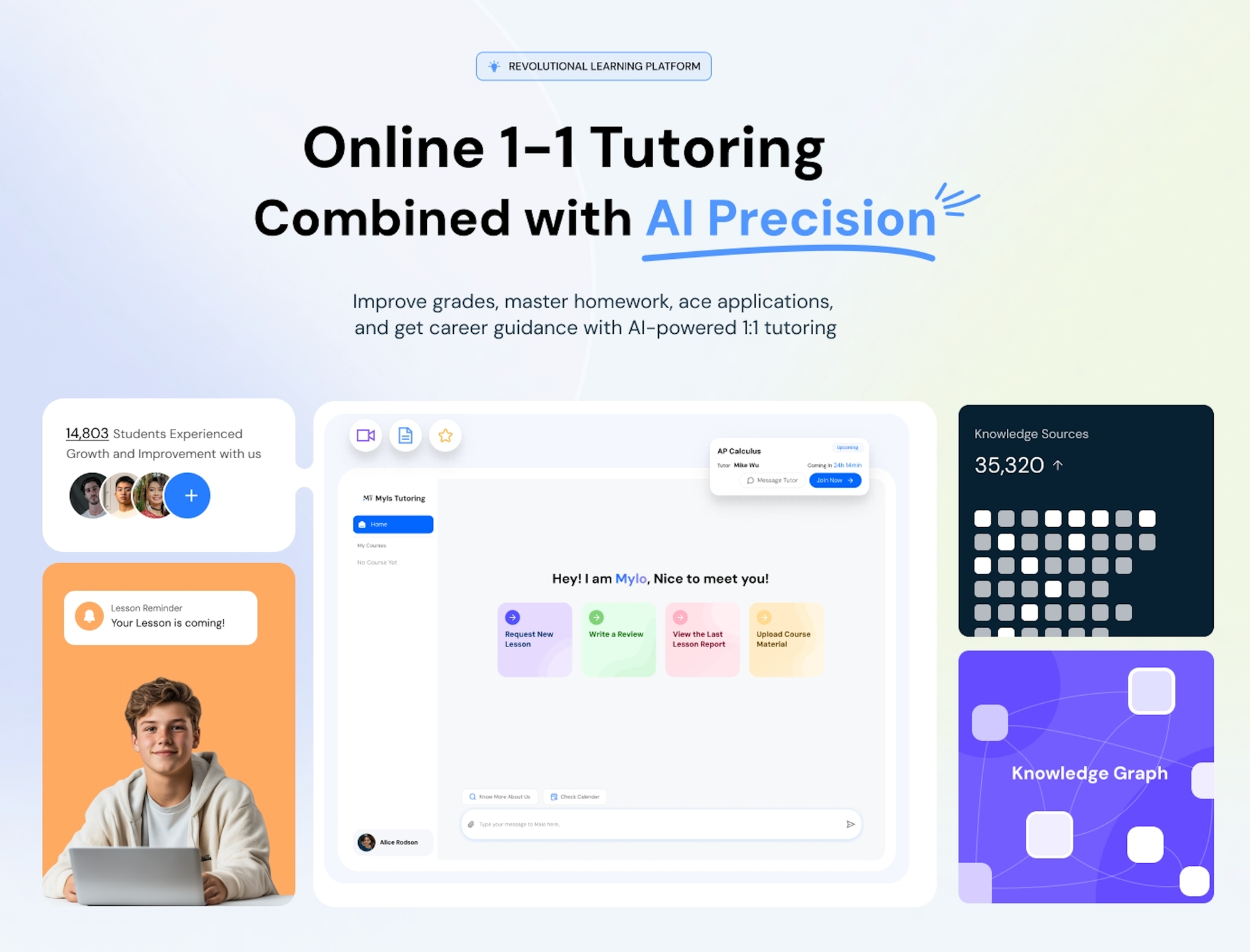Mastering AP Calculus AB: The Blueprint for Understanding Change in a Dynamic World
AP Calculus AB is a college-level math course focused on change, motion, and accumulation. This guide breaks down key topics, exam strategies, and shows how Myls Tutoring empowers students to succeed through personalized support and real-time progress tracking.

In today’s world, where data, dynamics, and decision-making shape nearly every industry, the ability to understand and model change is invaluable. Calculus is the language we use to describe and predict change—whether it’s the acceleration of a rocket, the spread of a virus, the optimization of a marketing campaign, or the turning point in an economic cycle.
AP Calculus AB is the entry point into this language. It’s a rigorous, college-level mathematics course offered to high school students, covering the foundational topics of differential and integral calculus. But more than that, it’s a course that teaches students how to reason logically, solve complex problems, and apply abstract principles to real-life contexts.
In this blog post, we’ll break down the structure, content, skills, and expectations of the AP Calculus AB course, while exploring how Myls Tutoring helps students go from confusion to confidence—ensuring they not only pass the AP exam, but also build long-term mathematical thinking skills.
AP Calculus AB Course Overview
AP Calculus AB is designed to mirror a first-semester college calculus course. It is focused primarily on two major branches of calculus: differential calculus (the study of rates of change) and integral calculus (the study of accumulation).
The College Board emphasizes four core skill categories in the AP Calculus AB curriculum:
- Procedural Fluency: Apply mathematical rules and procedures to evaluate expressions and solve problems.
- Representational Fluency: Move between verbal, graphical, numerical, and analytical forms of a function or situation.
- Conceptual Understanding and Justification: Use logic to support conclusions, justify steps, and understand the “why,” not just the “how.”
- Communication: Use precise mathematical language, symbols, and notation to convey solutions clearly.
Why Take AP Calculus AB?
- Earn University Credit: Many colleges offer credit for AP scores of 4 or 5, giving you a head start.
- Strengthen Problem-Solving Skills: The logic and structure of calculus sharpen critical thinking across disciplines.
- Build a STEM Foundation: From physics to economics, calculus is central to many university programs.
- Stand Out on Applications: Success in AP Calculus AB demonstrates readiness for academic rigor and quantitative thinking.
AP Calculus AB Course Structure
AP Calculus AB is designed to mirror a first-semester college calculus course. It is focused primarily on two major branches of calculus: differential calculus (the study of rates of change) and integral calculus (the study of accumulation).
The College Board emphasizes four core skill categories in the AP Calculus AB curriculum:
- Procedural Fluency: Apply mathematical rules and procedures to evaluate expressions and solve problems.
- Representational Fluency: Move between verbal, graphical, numerical, and analytical forms of a function or situation.
- Conceptual Understanding and Justification: Use logic to support conclusions, justify steps, and understand the “why,” not just the “how.”
- Communication: Use precise mathematical language, symbols, and notation to convey solutions clearly.
AP Calculus AB Course Unit-by-Unit Breakdown: Topics, Purpose, and Exam Weight
Unit 1: Limits and Continuity (10–12%)
- What you learn:
- This unit introduces the idea of a limit, which describes what a function approaches as the input nears a specific value. You learn to evaluate limits graphically, numerically, and algebraically. Continuity—a function’s behavior without jumps or holes—is discussed rigorously.
- Why it matters:
- Limits are the conceptual foundation of calculus. Without limits, we can’t define derivatives or integrals. Understanding when and how a function is continuous prepares students to study smooth, real-world phenomena like motion and growth.
- Key theorems and concepts:
- Limit properties
- One-sided limits
- Infinite limits and vertical asymptotes
- The Squeeze Theorem
- Intermediate Value Theorem (IVT)
Unit 2: Definition and Fundamental Properties of Derivatives (10–12%)
- What you learn:
- Here, students encounter the formal definition of a derivative as a limit: the rate of change of a function at a point. You learn to interpret derivatives graphically (as slopes), numerically (as change in values), and algebraically (using rules).
- Why it matters:
- Derivatives model instantaneous change—whether that’s velocity, marginal cost, or reaction rate. Understanding derivatives lets you analyze real-time changes with mathematical precision.
- Techniques introduced:
- Derivative as a limit
- Tangent lines and local linearity
- Differentiability and continuity
- Basic differentiation rules (power, constant, sum)
Unit 3: Derivatives of Composite, Implicit, and Inverse Functions (9–13%)
- What you learn:
- This unit expands your derivative toolkit. You learn the chain rule for handling compositions like f(g(x)), implicit differentiation for equations like x^2 + y^2 = 1, and how to differentiate inverse functions.
- Why it matters:
- Most real-world functions aren’t simple polynomials—they’re nested, implicit, or involve inverse relationships. This unit teaches students to model more complex behaviors and lays the groundwork for multivariable calculus later.
- New concepts:
- Chain rule
- Higher-order derivatives
- Implicit and logarithmic differentiation
- Inverses and their derivatives
Unit 4: Contextual Applications of Derivatives (10–15%)
- What you learn:
- This unit applies derivatives to real-world contexts: modeling velocity and acceleration, related rates, and approximations of function values near a point.
- Why it matters:
- Derivatives become tools, not just theoretical constructs. You’ll solve problems like: At what rate is water leaking from a tank? or How fast is a shadow growing? These are key applications in physics, biology, and engineering.
- Special topics:
- Related rates
- Linear approximation
- Motion along a line
- L’Hôpital’s Rule for limits of indeterminate forms
Unit 5: Analytical Applications of Derivatives (15–18%)
- What you learn:
- Students connect derivatives with function behavior: increasing/decreasing, concavity, extrema, and optimization. You’ll also sketch functions using first and second derivative information.
- Why it matters:
- This unit trains students to analyze functions deeply and interpret their structure. You also learn how to optimize quantities like profit or surface area—core to economics, architecture, and operations research.
- Essential tools:
- First and second derivative tests
- Curve sketching
- Mean Value Theorem (MVT)
- Optimization problems
- Candidates Test for extrema
Unit 6: Integration and Accumulation of Change (17–20%)
- What you learn:
- The course shifts to integration, or the accumulation of quantities over time. You’ll learn Riemann sums, definite and indefinite integrals, and the Fundamental Theorem of Calculus.
- Why it matters:
- If derivatives describe how things change, integrals describe how much has changed. Whether calculating distance from velocity, area under curves, or net consumption, integration connects motion and accumulation.
- Core skills:
- Area under a curve
- Riemann sums (left, right, midpoint)
- Fundamental Theorem of Calculus (Parts I & II)
- Integration techniques (substitution, properties)
Unit 7: Differential Equations (6–12%)
- What you learn:
- Students learn to solve basic separable differential equations, visualize slope fields, and model exponential growth and decay.
- Why it matters:
- Differential equations are used to describe population dynamics, radioactive decay, disease spread, and more. This unit introduces students to systems modeling—a cornerstone of modern science.
- Topics covered:
- General and particular solutions
- Slope fields and solution curves
- Growth/decay models
- Initial condition problems
Unit 8: Applications of Integration (10–15%)
- What you learn:
- You use definite integrals to solve geometric and motion problems—such as finding the area between curves, or the volume of a solid generated by rotating a region.
- Why it matters:
- This unit synthesizes all previous knowledge. You apply everything you’ve learned to analyze physical structures and dynamic systems using mathematics.
- Key applications:
- Area between curves
- Volume by disks and washers
- Volume by known cross-sections
- Average value of a function
- Motion modeling with integrals
AP Calculus AB Exam Overview
Format, Focus, and What’s Tested
The AP Calculus AB exam is 3 hours and 15 minutes long and includes:
Section I: Multiple Choice (50%)
- Number of Questions: 45 questions
- Time: 1 hour 45 minutes
- Mix of calculator and non-calculator parts
- Tests fluency, accuracy, and conceptual understanding
Section II: Free Response (50%)
- Number of Questions: 6 questions
- 2 calculator-active
- 4 no-calculator
- Time: 1 hour 30 minutes
- Tests ability to model, justify, and explain with proper mathematical notation
You’ll be expected to apply mathematical reasoning, use correct notation, and justify your answers clearly.
Graphing Calculator:
Permitted on designated parts. Students should be able to use it for graphing, numerical solutions, and estimating areas.
Conclusion: From Derivatives to Decisions—Calculus Is a Gateway
AP Calculus AB is a rigorous and fast-paced course that can be challenging to navigate without the right support. Myls Tutoring offers a comprehensive solution through personalized one-on-one tutoring with expert instructors who specialize in AP Calculus. These AP Calculus tutors identify each student’s individual learning gaps, provide targeted explanations, and build confidence through customized practice. What sets Myls Tutoring apart is its AI-powered learning diagnostics, which track student progress in real time and adapt instruction to their evolving needs.
In addition to covering core content, Myls Tutoring equips students with strategies to excel in both multiple-choice and free-response questions, emphasizing precise mathematical reasoning, proper use of calculus theorems, and avoidance of common mistakes. More than just academic support, Myls Tutors fosters problem-solving skills that extend into college-level mathematics, standardized testing, and future STEM careers. With Myls Tutoring, students gain not only the tools to master AP Calculus AB, but also the mindset to approach complex, real-world problems with clarity and confidence.
How Myls Tutoring Can Help You Succeed in AP Calculus AB

Tackling AP Calculus AB can be intimidating, but Myls Online Tutoring Platform makes it manageable—and even enjoyable.
✅ Find a Tutor Who Fits You: Myls tutors helps match students with the right tutor—someone who not only knows the content, but understands your learning style and pace.
✅ Personalized Learning Plans: Every student learns differently. Myls Online Tutoring Platform creates tailored lesson plans by using AI based on your strengths, weaknesses, and goals. Myls tutors will amend the lesson plans if necessary.
✅ Expert Tutors with AP Specialization: Learn from expert tutors who understand the AP curriculum and how the exam is scored.
✅ Step-by-Step Problem Solving: Myls online tutors break down complex problems into understandable parts so you can build confidence one concept at a time.
✅ Real-Time Progress Tracking: With Myls AI-enhanced Online Tutoring Platform, students and parents can monitor improvement and adjust focus areas accordingly.
✅ Practice That Mirrors the AP Exam: Myls Tutoring provides full support for both multiple-choice and free-response practice, including strategies for using your calculator effectively.
💡 Ready to Master AP Calculus AB?
Start your journey toward exam success and mathematical confidence.📚 Book a Free Trial Lesson Today!
Explore more AP courses on Myls Tutoring and get personalized support in subjects like Mathematics, Economics, Global Politics, Geography, and more!




